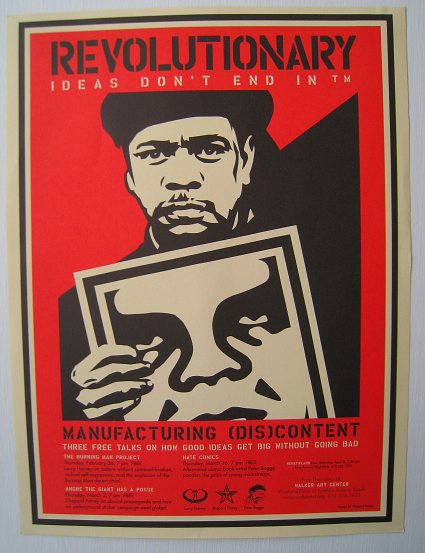
Nine years ago next week, back when Shepard Fairey was big enough to be the subject of a documentary, but well before he became a household name, he came to the Walker Art Center for a lecture series about "how big ideas get big without going bad." David Logan (now Kennedy-Logan) came up with the list of speakers -- Fairey, Burning Man founder Larry Harvey and HATE comics artist Peter Bagge -- and the Chomskyan series title, "Manufacturing (Dis)content." (Five years later, that would become the title of a book by Michael Perelman.) And he turned to me to help with the marketing concept.
From the start, we wanted to collaborate with Shepard on a poster, but it took some time for us to come up with a compelling concept. (I remember one headline favorite -- "Pissing in the mainstream" -- which we knew wouldn't fly with our institutional bosses.) Eventually, we agreed upon the lline "Revolutionary ideas don't end in ™." In retrospect, the trademark symbol perhaps didn't read clearly, but at the time we felt it conveyed the spirit of the series: how can good ideas take off without being co-opted, commodified or watered down.

Shepard created the imagery for the poster, appropriating an image of a beret-wearing African American man he's used on other pieces since. We also commissioned him to make a series of four buttons for the Walker's Target Free Thursday Nights. (I couldn't find a copy of the fourth one, but I remember it vividly, a fistful of dollars and the words "Free Enterprise.")
Here's the final poster:

3 comments:
The other button can be seen here:
http://media.walkerart.org/1570320.jpg
A little more info on the Teens website here:
http://teens.walkerart.org/#load=964
Fairey has reduced a rich and powerful history of socially-conscious art to the lowest common denominator. He symbolizes what is wrong with the art world and capitalism: he takes something of value, something beautiful and complex, and reduces it to the simplest, most easily digestible form of advertising: the brand. Fairey has branded himself, "political" art, "punk rock" and even the president of the United States.
Even though his work is unoriginal, redundant and shallow, the gallery and museum system doesn't care; they only see dollar signs. He preys on working artists, enriching himself while exploiting workers and artists as subject matter. From his hypocritical high horse, he has the nerve to preach to us about the dangers of capitalism, all the while using the system to his advantage. He has turned a subversive and political movement into just another fashion statement. Unfortunately, a sea of commercial artists and Hollywood Hipsters idolize him. They secretly dream of being rich and powerful also (despite their claims of being evolved), and Fairey gives them hope, proving that any hack with no talent can be an "art star".
Not only does he steal his subject matter and imagery from working artists and indigenous peoples, but he rarely makes his work himself. He is the Andy Warhol of our time; he has a factory of artists producing his work for him, everything from layout to printing to collage. He has stolen from the Black Panther movement, Vietnam political posters, Russian propaganda, punk rock and heavy metal. Some may call this appropriation, but there is a line between appropriation and stealing. Fairey has crossed this line many times (for a more detailed argument of this, please refer to the article "Obey Plagiarist Shepard Fairey" by Mark Vallen.) As an artist friend of mine once said, "Imitation is the sincerest form of unoriginality."
Schjeldahl covers some of these ^ objections in a review of Fairey's new exhibit in Boston, from this week's New Yorker:
http://www.newyorker.com/arts/critics/artworld/2009/02/23/090223craw_artworld_schjeldahl
Post a Comment